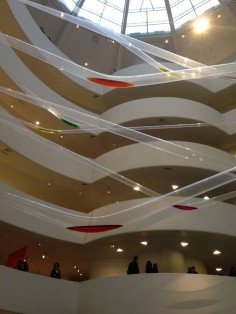MOTONAGA SADAMASA
元 永 定 正
Gutai: Splendid Playground
source: hundertmark-gallery
Sadamasa Motonaga was born in Ueno in 1922, died 1996.
in the artistic field he as comics design . In 1946 he took leson from M.Hamabe, an artist of colorStyle. His first paricipations in exhibitions took place on a level in 1948, for which he received numerous awards.
In July 1955 he joined the Gutai which he left again, however in Oktober 1971, give the following reasons: “Not because I Changed my mind about painting, but because I changned my mint about the view on life”.
.
.
.
.
.
.
.
source: metrous
Keep a dollar bill handy when you visit “Gutai: Splendid Playground,” the newest exhibition presented at the Guggenheim Museum. You’ll need one to trade the attendant for a token to use “Gutai Card Box,” a 1962 interactive piece refurbished for 2013 that dispenses small painted postcards. Four quarters won’t cut it. Try to score a token with a dollar in change, and the work’s attendant will inform you the $1 note policy is a non-negotiable “part of the performance of the piece.” The 145 works on display, created by 25 artists of Japan’s Gutai art collective between 1954 and 1972, range from the witty, the evocative, and the befuddling.
The name ‘gutai,’ or concreteness, refers to the incorporation of non-traditional objects and materials into art – a common trait in Gutai works. In one example, Shirago Kazuo’s “Challenging Mud,” the artist used his body to physically etch a design into a canvas of mud, which was later displayed alongside photos of the creative process. Tanaka’s “Electric Dress” is a wearable dress made of multi-colored light bulbs. The exhibition’s most visually dominant piece, “Work (Water),” was conceived specifically for the Guggenheim by Motonaga Sadamasa. A series of transparent tubes filled with brightly dyed water criss-crossing the rotunda far above the visitors’ heads, the installation tugs the eye upwards through the whimsically draped plastic all the way to the museum’s iconic skylight.
North America’s first-ever Gutai retrospective, “Splendid Playground” runs through May 8, 2013 and includes both classic and several newly commissioned, site-specific works by Gutai artists. Founded by Japanese artist Yoshihara Jiro, the collective generated one of avant-garde’s most influential movements of the post-World War II era. In a society newly freed from the bonds of totalitarianism, Jiro challenged his protégés to express freedom and agency through art. Co-curator Ming Tiampo credits Gutai’s enduring relevance to its playful, experimental spirit. “I think young artists have been responding with great enthusiasm to this work,” she said. “Although it was made in the ‘50s and ‘60s, it feels like it was just made yesterday.”
If the art itself doesn’t betray the Gutai movement’s age, inflation does. In 1962, Gutai Card Box only cost the viewer a 10-yen coin to activate – about 11 cents. No need for a paper bill to swing that.
.
.
.
.
.
.
.
source: budapestauction
Sadamasa Motonaga (元 永 定 正; Motonaga Sadamasa) é um artista japonês nascido em 1922 na Província de Mie. Ele é um membro fundador da Gutai movimento avant-garde. Em 1940, Sadamasa Motonaga estudou Belas Artes em Nakanoshima Osaka. Desde a fundação do movimento, ele se juntou Gutai e participou de sua primeira exposição em Tóquio, em 1955. Suas obras reabilitar matérias-primas, tais como pregos e madeira. Expôs seus trabalhos em Tóquio, Kyoto, Nova York, Turim, Washington, em 1959. A partir de 1980, ele exibiu e participou de Gutai retrospectiva no Japão e no mundo.


